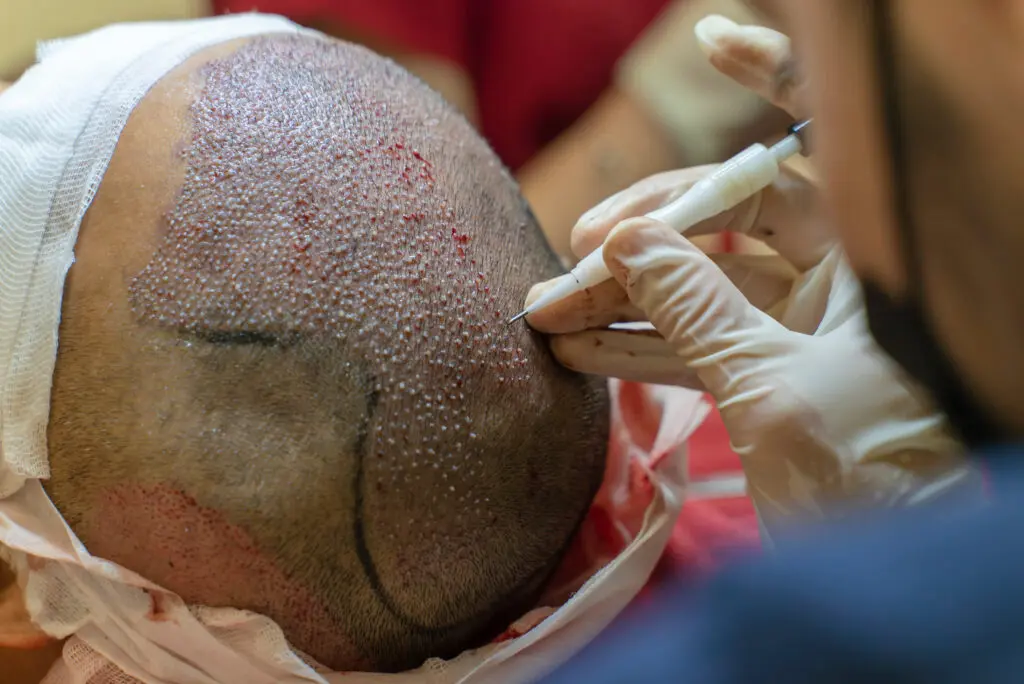
A Comprehensive Guide to Hair Graft Extraction and Implantation Techniques
According to a paper from Chin H. Ho, Tanuj Sood, and Patrick M. Zito, hair loss affects millions of people in the United States. For men, androgenetic alopecia can affect 50% by the age of 50, and for many, this can lead to a loss of self-esteem. If you are looking for a lasting solution, modern hair transplant methods offer a way to restore natural-looking hair with incredible success. The outcome, however, depends not just on the surgeon’s skill but on the precise techniques used to extract, preserve, and implant the hair grafts.
In this article, we will explore the various hair transplant methods available so you can make a better choice for yourself.
- Hair Grafts Explained: Single vs. Multiple Grafts and Why They Matter
- Understanding the Core Graft Extraction Techniques
- DHI vs FUE – Common Misconceptions
- Protecting Your Investment: The Science of Graft Preservation and Handling
- Artistry and Precision: A Look at Modern Hair Graft Implantation Techniques
- Your Personalized Plan: How to Choose the Right Hair Transplant Technique
- Hair Graft Techniques: Hair Loss Solutions To Fit Your Situation
Hair Grafts Explained: Single vs. Multiple Grafts and Why They Matter
A follicular unit graft is the basic building block for hair transplantation techniques. Each graft is a naturally occurring bundle of one to four hairs that is surrounded by sebaceous glands, connective tissue, and a small piece of skin.
- Single hair grafts: Used to create a soft, natural-looking hairline
- Double or triple hair grafts: Used to build density and fullness in the mid-scalp or crown
Preserving the integrity of these units during extraction and implantation is critical. If damaged, hair follicles have poor survival rates, leading to disappointing growth after surgery.
Understanding the Core Graft Extraction Techniques
There are two different extraction techniques you need to know. They are:
A. Follicular Unit Transplantation (FUT)
Also known as the “strip method,” the FUT procedure involves surgically removing a strip of scalp from the donor area (typically the back of the head). This strip is then meticulously dissected under a stereo-microscope into thousands of individual grafts.
Advantages:
- High graft yield in one session
- Efficient for patients requiring large numbers of grafts
Disadvantages:
- Leaves a linear scar at the donor site
- Longer recovery time compared to newer techniques
FUT (strip) is less commonly chosen by some clinics because it leaves a linear scar, but it still has valid indications. FUT can be efficient when very high graft counts are needed in a single session and may provide higher initial graft yield in experienced hands. The choice between FUT and FUE should be individualized based on patient goals, donor characteristics, scalp laxity, and scarring preferences.
B. Follicular Unit Extraction (FUE)
This is a minimally invasive method where individual follicular units are extracted directly from the donor area using a small, circular punch tool.
Types of FUE tools:
- Manual punches: Surgeon-controlled, precise but slow
- Motorized punches: Faster, require careful skill to avoid transection
- Robotic systems (e.g., ARTAS): Assist with accuracy and speed
Variants of FUE:
- Sapphire FUE: Uses sapphire blades for finer, cleaner incisions
- Micro/Ultra-refined FUE: Employs very small punches for reduced scarring and faster healing
Pros:
- No linear scar, only tiny dot-like marks
- Faster recovery compared to FUT
Cons:
- More time-consuming for large sessions
- Requires a highly skilled surgeon to minimize graft damage
DHI vs FUE – Common Misconceptions
Direct Hair Implantation (DHI) (Choi Implanter) is an implantation variant of FUE that allows the surgeon to insert grafts without creating all recipient sites in advance. Potential practical advantages described by surgeons include reduced handling of grafts and finer control of direction/angle/depth during placement.
However, randomized controlled data showing consistent, clinically meaningful improvement in long-term graft survival compared with standard slit/forceps implantation are limited. Most sources classify DHI as an implantation preference rather than an established superiority in survival.
Choice of implantation technique is often driven by surgeon experience, session size, and recipient area requirements rather than definitive evidence of higher survival with DHI.
Protecting Your Investment: The Science of Graft Preservation and Handling
Even the best extraction method can fail without proper graft preservation. Once outside the body, follicles are vulnerable. Clinics use advanced protocols to protect them:
- Storage solutions like saline, HypoThermosol, or ATP-based solutions keep grafts hydrated and viable
- Chilled environments slow metabolic activity, prolonging survival
Proper hydration and temperature control are crucial to a successful hair transplant that results in strong, natural results rather than poor growth.
Artistry and Precision: A Look at Modern Hair Graft Implantation Techniques

There are three kinds of techniques to be aware of:
A. Slit Implantation
A traditional and widely used method where a surgeon first creates tiny incisions (slits) in the recipient area with a blade or needle. Grafts are then carefully placed into these pre-made slits using forceps.
B. DHI (Choi Implanter Pen)
As described above, this advanced technique uses the implanter pen to create the incision and place the graft in a single motion. This ensures minimal handling of the graft and less trauma to the scalp, increasing survival rates.
C. Stick-and-Place Technique
Here, the surgeon makes one incision and immediately places the graft with forceps before moving to the next. While time-consuming, it’s extremely useful for small touch-ups or transplanting into challenging areas like scar tissue.
Your Personalized Plan: How to Choose the Right Hair Transplant Technique
Selecting the best approach depends on multiple factors:
- Hair loss pattern: Extensive baldness may favor FUT, while moderate loss may be ideal for FUE or DHI
- Donor hair availability: Limited donor supply requires careful extraction and high survival rates
- Patient preferences: Some may prioritize minimal scarring; others may want the most grafts in a single session
Ultimately, the decision should be made after consultation with a board-certified hair transplant surgeon who can assess individual needs and recommend the most suitable method.
Hair Graft Techniques: Hair Loss Solutions To Fit Your Situation
There is no one-size-fits-all solution in hair graft extraction and implantation. The best outcomes are achieved when an experienced hair transplant surgeon matches the right technique to the right patient. As technology advances, innovations in robotics, graft preservation, and implantation precision will only continue to enhance success rates.
At Elithair, the world’s largest hair loss clinic, we have performed over 150,000 successful hair restorations, delivering life-changing results in just 6-12 months. We believe patient education is the key to making a confident decision.Contact us for a free hair analysis today, and let our experts help you choose the best path forward for your hair.
FAQs
How long do hair grafts last?
Transplanted follicular units are generally permanent because they are typically taken from donor scalp areas that are genetically resistant to androgenetic miniaturization (donor-dominance)rnrnThat said, outcomes depend on donor stability, proper surgical technique, and ongoing factors (e.g., age, progression of hair loss, medical comorbidities). Some patients may still experience thinning of native (non-transplanted) hair or require complementary medical therapy (finasteride/minoxidil) to maintain an optimal result.
What is a hair graft?
A hair graft is a small unit of tissue containing one or more hair follicles that can be transplanted to a thinning or balding area.
How many hairs are 2000 grafts?
Typical range is 1-4 hairs per graft; therefore, 2,000 grafts commonly yield ~3,000-5,000 hairs in practice, depending on donor hair follicle composition (many grafts are 2-hair units).
How many hairs are in one graft?
One graft typically contains 1 to 4 hairs, though the number varies depending on natural follicle groupings.


